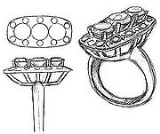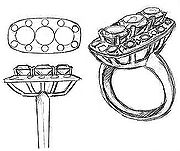
Jewelry design
Encyclopedia

Fabrication (metal)
Fabrication as an industrial term refers to building metal structures by cutting, bending, and assembling. The cutting part of fabrication is via sawing, shearing, or chiseling ; torching with handheld torches ; and via CNC cutters...
, or rendering
Artistic rendering
Rendering in visual art and technical drawing means the process of creating, shading, and texturing of an image, especially a photorealistic one. It can also be used to describe the quality of execution of that process...
designs for jewelry. This is an ancient practice of the goldsmith
Goldsmith
A goldsmith is a metalworker who specializes in working with gold and other precious metals. Since ancient times the techniques of a goldsmith have evolved very little in order to produce items of jewelry of quality standards. In modern times actual goldsmiths are rare...
or metalworker that evolved to a billion-dollar industry with the odyssey from ancient cultures into the machine age
Industrial Revolution
The Industrial Revolution was a period from the 18th to the 19th century where major changes in agriculture, manufacturing, mining, transportation, and technology had a profound effect on the social, economic and cultural conditions of the times...
. Jewelry design falls under the category of what is commonly known as "functional art," being art that can be worn or used.
Before an article of jewelry is created, design concepts are rendered followed by detailed technical drawing
Technical drawing
Technical drawing, also known as drafting or draughting, is the act and discipline of composing plans that visually communicate how something functions or has to be constructed.Drafting is the language of industry....
s generated by a jewelry designer
Jewelry designer
A jewellery designer or jewelry designer is a person who renders original jewellery creations and usually constructs them as well...
, a professional who is trained in the architectural and functional knowledge of fabrication techniques, composition, wearability and market trends.
Traditional hand-drawing and drafting methods are still utilized in designing jewelry particularly at the conceptual stage, but a shift is taking place to computer-aided design programs like Rhinoceros 3D
Rhinoceros 3D
Rhinoceros is a stand-alone, commercial NURBS-based 3-D modeling tool, developed by Robert McNeel & Associates. The software is commonly used for industrial design, architecture, marine design, jewelry design, automotive design, CAD / CAM, rapid prototyping, reverse engineering as well as the...
and Matrix.
Once conceptual/ideation is complete, the design is rendered and fabricated using the necessary materials for proper adaptation to the function of the object. For example, 24K gold
Gold
Gold is a chemical element with the symbol Au and an atomic number of 79. Gold is a dense, soft, shiny, malleable and ductile metal. Pure gold has a bright yellow color and luster traditionally considered attractive, which it maintains without oxidizing in air or water. Chemically, gold is a...
was used in ancient jewelry design because it was more accessible than silver
Silver
Silver is a metallic chemical element with the chemical symbol Ag and atomic number 47. A soft, white, lustrous transition metal, it has the highest electrical conductivity of any element and the highest thermal conductivity of any metal...
as source material. Before the 1st century many civilizations also incorporated beads into jewelry. Once the discovery of gemstone
Gemstone
A gemstone or gem is a piece of mineral, which, in cut and polished form, is used to make jewelry or other adornments...
s and gem cutting
Gemcutter
A gemcutter, is a person who cuts, shapes, and polishes natural and synthetic gemstones. In historical use it usually refers to an artist who made hardstone carvings or engraved gems, a branch of miniature sculpture or ornament in gemstone....
became more readily available, the art of jewelry ornamentation and design shifted. The earliest documented gemstone cut was done by Theophilus Presbyter
Theophilus Presbyter
Theophilus Presbyter is the pseudonymous author or compiler ofa Latin text containing detailed descriptions of various medieval arts, a text commonly known as the Schedula diversarum artium or De diversis artibus , probably first compiled between 1100 and 1120...
(c. 1070 - 1125), who practiced and developed many applied arts and was a known goldsmith. Later, during the 14th Century, medieval lapidary
Lapidary
A lapidary is an artist or artisan who forms stone, mineral, gemstones, and other suitably durable materials into decorative items such as engraved gems, including cameos, or cabochons, and faceted designs...
technology evolved to include cabochon
Cabochon
A cabochon , from the Middle French caboche , is a gemstone which has been shaped and polished as opposed to faceted. The resulting form is usually a convex top with a flat bottom. Cutting en cabochon is usually applied to opaque gems, while faceting is usually applied to transparent stones...
s and cameos.
Early Jewelry design commissions were often constituted by nobility or the church to honor an event or as wearable ornamentation. Within the structure of early methods, enameling
Vitreous enamel
Vitreous enamel, also porcelain enamel in U.S. English, is a material made by fusing powdered glass to a substrate by firing, usually between 750 and 850 °C...
and repoussé
Repoussé and chasing
Repoussé or repoussage is a metalworking technique in which a malleable metal is ornamented or shaped by hammering from the reverse side to create a design in low relief. There are few techniques that offer such diversity of expression while still being relatively economical...
became standard methods for creating ornamental wares to demonstrate wealth, position, or power. These early techniques created a specific complex design element that later would forge the baroque
Baroque
The Baroque is a period and the style that used exaggerated motion and clear, easily interpreted detail to produce drama, tension, exuberance, and grandeur in sculpture, painting, literature, dance, and music...
movement in jewelry design.

